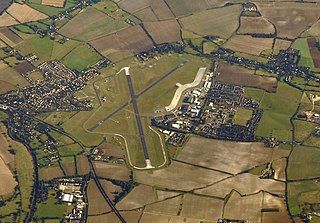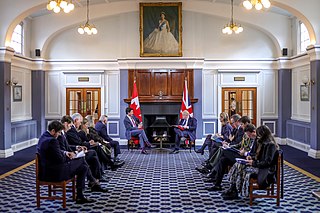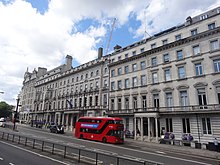
The Air Ministry was a department of the Government of the United Kingdom with the responsibility of managing the affairs of the Royal Air Force, that existed from 1918 to 1964. It was under the political authority of the Secretary of State for Air.

Royal Air Force Halton, or more simply RAF Halton, is one of the largest Royal Air Force stations in the United Kingdom. It is located near the village of Halton near Wendover, Buckinghamshire. The site has been in use since the First World War but is due to close by December 2027.

St Clement Danes is an Anglican church in the City of Westminster, London. It is situated outside the Royal Courts of Justice on the Strand. Although the first church on the site was reputedly founded in the 9th century by the Danes, the current building was completed in 1682 by Sir Christopher Wren. Wren's building was gutted by Luftwaffe bombing raids during the Blitz and not restored until 1958, when it was adapted to its current function as the central church of the Royal Air Force.

Marshal of the Royal Air Force (MRAF) is the highest rank in the Royal Air Force (RAF). In peacetime it was granted to RAF officers in the appointment of Chief of the Defence Staff (CDS), and to retired Chiefs of the Air Staff (CAS), who were promoted to it on their last day of service. While surviving Marshals of the RAF retain the rank for life, the highest rank to which officers on active service are promoted is now air chief marshal. Although general promotions to Marshal of the Royal Air Force have been discontinued since the British defence cuts of the 1990s, further promotions to the rank may still be made in wartime, for members of the Royal Family and certain very senior RAF air officers in peacetime at the discretion of the monarch; all such promotions in peacetime are only honorary, however. In 2012, the then Prince of Wales was promoted to the rank in recognition of his support for his mother, Queen Elizabeth II, in her capacity as head of the armed forces (commander-in-chief), while in 2014 Lord Stirrup, who had served as Chief of the Air Staff and Chief of the Defence Staff for over seven years, was also promoted.

Royal Air Force Benson or RAF Benson is a Royal Air Force (RAF) station located at Benson, near Wallingford, in South Oxfordshire, England. It is a front-line station and home to the RAF's fleet of Westland Puma HC2 support helicopters, used primarily for the transportation of troops & equipment. Flying squadrons comprise No. 33 Squadron flying the Puma, No. 22 Squadron which provides operational evaluation and training for all aircraft in Joint Helicopter Command and No. 28 Squadron, which is the combined Puma and Boeing Chinook HC6A training unit. Other units include the Oxford University Air Squadron and No. 6 Air Experience Flight, both flying the Grob Tutor T1 light training aircraft used for student and cadet flying training. The National Police Air Service and the Thames Valley Air Ambulance are also based at the station, both operating Airbus H135 helicopters.
The Guinea Pig Club, established in 1941, was a social club and mutual support network for British and allied aircrew injured during World War II. Its membership was made up of patients of Archibald McIndoe in Ward III at Queen Victoria Hospital, East Grinstead, Sussex, who had undergone experimental reconstructive plastic surgery, including facial reconstruction, generally after receiving burns injuries in aircraft. The club remained active after the end of the war, and its annual reunion meetings continued until 2007.

Royal Air Force Northolt or more simply RAF Northolt is a Royal Air Force station in South Ruislip, 2 nautical miles from Uxbridge in the London Borough of Hillingdon, western Greater London, England, approximately 6 mi (10 km) north of Heathrow Airport. The station handles many private civil flights in addition to Air Force flights. Northolt has one runway in operation, spanning 1,687 m × 46 m, with a grooved asphalt surface. This airport is used for government and VIP transport to and from London.

The Royal Air Force Regiment is part of the Royal Air Force and functions as a specialist corps. Founded by Royal Warrant in 1942, the Corps carries out soldiering tasks relating to the delivery of air power. Examples of such tasks are non-combatant evacuation operation (NEO), recovery of downed aircrew, and in-depth defence of airfields by way of aggressively patrolling and actively seeking out infiltrators in a large area surrounding airfields. In addition the RAF Regiment provides Joint Terminal Attack Controllers (JTACs) to the British Army in the Tactical Air Control Party (TACP) role, and provides flight size commitment to the Special Forces Support Group.

Marshal of the Royal Air Force Arthur William Tedder, 1st Baron Tedder, was a Scottish senior Royal Air Force commander. He was a pilot and squadron commander in the Royal Flying Corps in the First World War and he went on to serve as a senior officer in the Royal Air Force during the inter-war years when he served in Turkey, Great Britain and the Far East.
Marshal of the air force or marshal of the air is a five-star rank and an English-language term for the most senior rank in some air forces. It is usually the direct equivalent of a general of the air force in other air forces, a field marshal or general of the army in many armies, or a naval admiral of the fleet.

RAF Uxbridge was a Royal Air Force (RAF) station in Uxbridge, within the London Borough of Hillingdon, occupying a 44.6-hectare (110-acre) site that originally belonged to the Hillingdon House estate. The British Government purchased the estate in 1915, three years before the founding of the RAF. Until the outbreak of the Second World War in 1939, the station was open to the public.

The Shoreham Aircraft Museum is located in the village of Shoreham near Sevenoaks in Kent, England, on the south-east edge of Greater London. It was founded by volunteers in 1978 and is dedicated to the airmen who fought in the skies over southern England during the Second World War.

No. 1 School of Technical Training is the Royal Air Force's aircraft engineering school. It was based at RAF Halton from 1919 to 1993, as the Home of the Aircraft Apprentice scheme. The Aircraft Apprentice scheme trained young men in the mechanical trades for aircraft maintenance, the graduates of which were the best trained technicians in the RAF and would usually progress to Senior NCO ranks. However, ninety one ex-apprentices went on to achieve Air Rank. Many more became commissioned officers, including Sir Frank Whittle "father of the jet engine", who completed his apprenticeship at RAF Cranwell, before the move to RAF Halton. Graduates of the Aircraft Apprentice scheme at RAF Halton are known as Old Haltonians.

Marshal of the Royal Air Force Sir John Maitland Salmond, was a British military officer who rose to high rank in the Royal Flying Corps and then the Royal Air Force. During the First World War he served as a squadron commander, a wing commander and then as General Officer Commanding the RAF on the Western Front towards the end of the war. He went on to be Air Officer Commanding British Forces in Iraq in the early 1920s when he halted a Turkish invasion and sought to put down a Kurdish uprising against King Faisal, the British-sponsored ruler of Iraq. He was Chief of the Air Staff in the early 1930s and bitterly opposed the position taken by British politicians at the World Disarmament Conference in Geneva, which would have led to the UK's complete aerial disarmament. In the event the talks broke down when Adolf Hitler withdrew from the Conference in October 1933.

Marshal of the Royal Air Force Sir William Forster Dickson,, was a Royal Naval Air Service aviator during the First World War, a senior officer in the Royal Air Force during the inter-war years and a Royal Air Force commander during and after the Second World War. Dickson was Chief of the Air Staff in the mid-1950s, in which role his main preoccupation was the establishment of the V Force and the necessary supporting weapons, airfields and personnel. He also served as the first Chief of the Defence Staff in the late 1950s.

The Royal Auxiliary Air Force (RAuxAF), formerly the Auxiliary Air Force (AAF), together with the Air Force Reserve, is a component of His Majesty's Reserve Air Forces. It provides a primary reinforcement capability for the regular service, and consists of paid volunteers who give up some of their weekends, evenings and holidays to train at one of a number of squadrons around the United Kingdom. Its current mission is to provide trained personnel in support of the regular RAF.
Group Captain George Cecil Gardiner was a World War I flying ace credited with six aerial victories.
Flight Lieutenant Frank George Gibbons was a British First World War flying ace credited with fourteen aerial victories. He served in the Royal Air Force post-war, until killed in a flying accident during an air race.

Annie Pearson, Viscountess Cowdray, GBE was an English society hostess, suffragist and philanthropist. She was nicknamed the "Fairy Godmother of Nursing" due to her financial patronage of the Royal College of Nursing and her work to promote district nursing throughout England and Scotland. She served as the President of the Women's Liberal Federation from 1921 until 1923 and was also the Honorary Treasurer of the Liberal Women's Suffrage Union. She was the only woman to hold the office of High Steward of Colchester, serving from 1927 until her death in 1932.

This is a list of personnel numbers in the Royal Air Force, from its inception in 1918, up until the modern day. Royal Air Force staffing numbers have fluctuated with periodic demand, however, since the end of the Second World War, numbers have decreased steadily and the RAF itself has shrunk in terms of operating bases. Several schemes have been implemented during times of excess staffing to reduce numbers.















